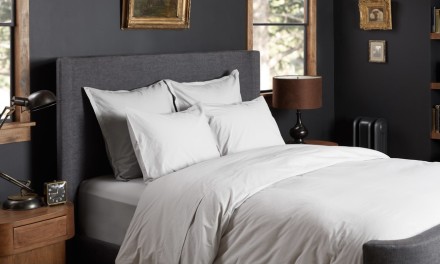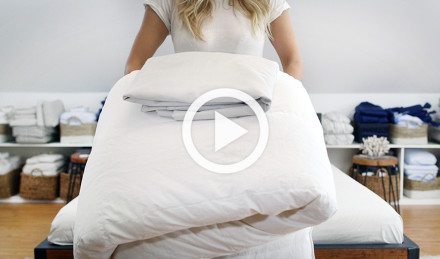Cotton is by far the most popular textile worldwide — and for good reason. The earth-sourced plant fiber is not only easy to grow in many parts of the world but also relatively affordable and suitable for all types of sleepers.
But why is this textile a global favorite for bed linens, and what are the best cotton sheets? Keep reading for answers to these questions, along with a breakdown of the different types of cotton and what to look for when shopping for bedding.
Why Cotton?
Why Cotton?
Cotton is naturally breathable, meaning air can pass through the material. This makes it ideal for hot sleepers and those prone to night sweats. But while it won't cause you to overheat by trapping warm air like synthetic fabrics, it’s an excellent choice for those who like a cozier bedding setup as well. Cotton is also unlikely to irritate sensitive skin.
And that's not all. The material is inherently soft, and depending on the specific type and weave, it can get increasingly softer with time. Unlike polyester, rayon and other synthetic fabrics, cotton is also biodegradable, making it one of the most sustainable textiles on the market. With proper care, it's long-lasting too.
The Best Cotton Bed Sheet Materials
Another reason cotton is so great is that it's incredibly versatile. With different cotton plant varieties, plus several weaves and styles, there are myriad types of cotton bedding to explore.
So, what's the best cotton for sheets? The top choices include organic cotton, Turkish cotton and long-staple Egyptian cotton. Get details about each option below.
Organic Cotton
The Best Cotton Bed Sheet Materials
Another reason cotton is so great is that it's incredibly versatile. With different cotton plant varieties, plus several weaves and styles, there are myriad types of cotton bedding to explore.
So, what's the best cotton for sheets? The top choices include organic cotton, Turkish cotton and long-staple Egyptian cotton. Get details about each option below.
Organic Cotton
Some of the best cotton sheets are made of organic cotton. This eco-friendly textile is woven from the fibers of organically grown cotton plants, which are cultivated without artificial pesticides or fertilizers. Additionally, cotton plants can only be classified as organic if they're planted from non-GMO (genetically modified organism) seeds.
Various regulations dictate how organic cotton is grown and harvested. The U.S. Department of Agriculture (USDA) and the Federal Trade Commission (FTC) oversee certifications in the U.S., and the Global Organic Textile Standard (GOTSⓇ) certifies organic textiles around the world — more on this below.
What Is Organic Cotton? Read our blog for additional insight, then check out our guide to the Best Organic Bed Sheets.
Turkish Cotton
Many would argue the best cotton sheets are the Turkish variety. Cotton plants grown in Turkey produce long-staple fibers, which are woven into fabric. The longer the fiber, the stronger the fabric.
Thanks to this inherent durability, Turkish cotton bedding is known for its ability to get softer over time. Since long-staple threads have fewer edges, materials loomed from them are less likely to fray and pill. This allows the fabric to not only hold up through years of use and weekly washes but also become increasingly soft.
What Is Turkish Cotton? Read our article for a deeper dive into this high-quality bedding material.
Long-Staple Egyptian Cotton
Another popular type of long-staple cotton sheets comes from plants grown in Egypt. Since the early 1800s, cotton has been one of the country's most highly cultivated crops. With the help of centuries-old irrigation systems, the plants are able to thrive in the sunny climate and produce extra-long-staple fibers.
Most modern Egyptian cotton is sourced from crops grown along the Nile Delta. The region boasts one of the country's more moderate climates, as well as fertile soil and high sun — an ideal environment for cultivating coveted long-staple cotton plants.
Like Turkish cotton, Egyptian cotton bedding is exceedingly durable and long-lasting. Sheets made of the fabric are unlikely to pill, fray or tear, and they get softer with every wash.
What Is Long-Staple Egyptian Cotton? Get more details in our blog, and learn why some of the best cotton sheet sets are sourced from this material.
Cotton Bedding Weaves to Consider
Now you know what raw materials are used to make the best cotton sheets, but what about the weave? A few of the most popular, highest-quality bedding weaves include percale, sateen, brushed cotton, cloud cotton, air cotton, honeycomb and knit. Here's what to know.
Percale
Cotton Bedding Weaves to Consider
Now you know what raw materials are used to make the best cotton sheets, but what about the weave? A few of the most popular, highest-quality bedding weaves include percale, sateen, brushed cotton, cloud cotton, air cotton, honeycomb and knit. Here's what to know.
Percale
Percale is a cool and crisp cotton fabric loomed with a plain square weave pattern (one thread over, one under). Sourced from certified long-staple Egyptian cotton with a lightweight feel and a smooth matte finish, Parachute carries some of the best percale sheets on the market.
Find out more in our article, Percale: Know Your Bedding Like a Designer.
Sateen
Like percale, sateen is made of long-staple Egyptian cotton fibers. But unlike percale, it features a satin weave pattern (three threads over, one thread under). Though it's not as shiny as satin, this makes the fabric incredibly smooth with a silky quality and a subtle sheen.
Since the weave is a bit tighter than the plain square weave, cotton sateen sheets have a slightly heavier drape. This makes them ideal for those who get cold at night or want a thicker fabric for winter.
Get more details in our blog, Sateen: Know Your Bedding Like a Designer.
Brushed Cotton
If a comfy-cozy feel is a top priority, brushed cotton is for you. This sheet set from Parachute is woven from 100% cotton with a plain square weave, then gently combed on one side to create a buttery-soft feel while enhancing its insulation.
Learn more about these ultra-soft cotton sheets in our blog, Brushed Cotton: Know Your Bedding Like a Designer.
Cloud Cotton
Aside from the best cotton sheets, there are a few other bedding weaves to consider, starting with cloud cotton. The material is sourced from long-staple Turkish cotton and features multiple layers of gauzy fabric. This makes it exceptionally fluffy and lightweight but still super cozy. You can find duvet covers, shams, quilts, and even bathrobes in cozy, luxurious cloud cotton.
Honeycomb
A honeycomb cotton duvet cover is the perfect addition to cotton bed sheets. Loomed from a breathable blend of cotton and linen, this bedding set features a waffle-style textured front and a smooth percale weave on the back.
Learn more in our guide to Waffle Weave Essentials for Your Bedroom & Bathroom.
Air Cotton
Air cotton is another exceptional bedding option. This light-as-air fabric is crafted from multiple layers of organic cotton, then yarn-dyed and garment washed for maximum softness. You’ll find high-quality air cotton bedding at Parachute in the form of quilts and decorative Euro shams.
What Are Euro Shams and Euro Pillows? Read our blog to find out.
Knit
Put the finishing touch on your bed with knits. Consider this oversized knit throw, which is made of 100% Turkish cotton and knitted into a sweater-like ribbed pattern. This organic cotton knit throw is another great option with its chunky stitch pattern and extremely soft texture.
See our guide to Quilts, Blankets and Coverlets for more bed-layering inspiration.
What About Thread Count?
Not all cotton fabrics are created equal. As noted above, long-staple fibers are crucial to a fabric's durability and softness. And despite popular misconception, this component is more important than thread count.
Lots of folks view thread count as an indicator of bedding quality, with the idea being that higher counts mean better quality. However, there are no regulations about what numbers brands can or can't claim, and in the end, it's mostly a marketing gimmick.
Learn more in our blog, The Truth About Thread Count.
Certifications for the Best Cotton Sheets
Certain labels can help you identify high-quality fabrics. When shopping around for cotton bed linens, look for products certified as Oeko-Tex, or GOTS.
Oeko-Tex Standard 100
Certifications for the Best Cotton Sheets
Certain labels can help you identify high-quality fabrics. When shopping around for cotton bed linens, look for products certified as Oeko-Tex, or GOTS.
Oeko-Tex Standard 100
Some of the best cotton sheets carry a third-party certification from Oeko-Tex. When you see the Oeko-Tex Standard 100 label, you can rest assured the material was produced without upwards of 100 substances known to cause harm to humans and the planet. This includes everything from the raw plant fibers and dyes to the threads and garment-washing solutions.
Read our articles to learn more about the benefits of Oeko-Tex cotton:
GOTSⓇ
As noted above, the Global Organic Textile Standard is the leading certifier of organic fabrics worldwide. The third-party organization ensures bedding and other textiles are sourced from organically grown plants (as with cotton) or organically raised livestock (such as with sheep's wool). Additionally, the label tells you each stage of the manufacturing process meets GOTS's strict ecological and social criteria.
Read our blog for more insight into GOTS-certified organic cotton:
Climate Neutral
When you buy bedding from a Climate Neutral Certified brand, you know the manufacturing process and supply chain aren't contributing to the deterioration of the environment. Companies with this certification have various strategies and standards for offsetting and minimizing their greenhouse gas emissions.
Parachute Is Climate Neutral Certified! Find out more about the journey to getting here and our long-term sustainability vision in our blog.
Other Natural Bed Sheet Materials to Consider
Beyond the best cotton sheets, there are many other naturally sourced bedding materials to consider, including linen, silk, bamboo and wool.
Linen
Other Natural Bed Sheet Materials to Consider
Beyond the best cotton sheets, there are many other naturally sourced bedding materials to consider, including linen, silk, bamboo and wool.
Linen
Linen comes from flax plants. When woven into fabric, the long, hollow fibers make for exceptionally durable yet lightweight and breathable bedding. Like long-staple cotton, casually elegant linen can last several years and gets softer with time.
For more on this material, see our articles, Linen: Know Your Bedding Like a Designer and Why is European Flax Linen the Best in the World?
Silk
Silk is sourced from mulberry worms. In addition to its luxurious appeal and subtly shiny finish, the material is a top choice for pillowcases. The idea is that the sumptuously smooth surface minimizes friction on your skin and hair, so it won't contribute to as many creases or split ends.
Check out our guide to explore the difference between Sateen vs. Satin vs. Silk.
Wool
Sheep regrow their coats quickly after being shorn, so wool is considered a renewable material as well. Wool isn't used to make sheets, but the naturally insulating and endlessly cozy textile is a go-to for blankets, like this handwoven wool throw or this wool-cashmere blend throw.
What Is Merino Wool? Get details in our blog.
Bamboo
Bamboo is another earth-sourced fabric that's been gaining popularity in recent years. It's inherently breathable with natural moisture-wicking abilities, making it a good choice for people who sweat at night. And since bamboo trees regrow super fast after the shoots are harvested, they're considered a sustainable resource.
Where to Buy the Best Cotton Sheets and Bedding
Parachute is your resource for high-quality cotton bedding. When you browse the selection, you'll find percale, sateen, brushed cotton and organic cotton sheets and comforter covers. In addition to full sets, you can buy a fitted cotton sheet, a cotton top sheet, cotton pillowcases or a duvet cover individually.
Shop the collections today!
Read Next:
Are Organic Sheets Worth It? What to Look for in Organic Bedding
Does Cotton Shrink? Keep Your Cotton Clothing and Sheets From Shrinking
Does Linen Shrink? Keep Your Cotton Clothing and Sheets From Shrinking
Best Organic Clothing Guide: What Natural Clothes to Buy for You and Your Kids
Best Organic Towels: What to Look for in Sustainable Bath Towels
35 Eco-Friendly Home Products: Necessities for a Sustainable Household
External Sources:
1. Introduction to Textiles & the Textile Industry. Textile Industry Types. (2022) Overview of the Cotton Industry.
2. Mason, Rupert. Fabrics for atopic dermatitis. The journal of family health care vol. 18,2 (2008): 63-5.
3. Manickam S. (2014). Research Article Studies on fibre quality of a long staple cotton variety using high volume instrument and advanced fibre information system for fibre quality improvement. Electronic Journal of Plant Breeding. 5. 213-219.
4. Schwartzstein P. (2016) How the American Civil War Built Egypt's Vaunted Cotton Industry and Changed the Country Forever. Smithsonian Magazine.
5. Rekha, R. & Sudam, A.. (2009). Bamboo: Green and breathable natural fiber. Man-Made Textiles in India. 52. 397-401.
6. Wiedemann S, et al. Environmental impacts associated with the production, use, and end-of-life of a woollen garment. Int J Life Cycle Assess 25, 1486–1499 (2020). https://doi.org/10.1007/s11367-020-01766-0
Where to Buy the Best Cotton Sheets and Bedding
Parachute is your resource for high-quality cotton bedding. When you browse the selection, you'll find percale, sateen, brushed cotton and organic cotton sheets and comforter covers. In addition to full sets, you can buy a fitted cotton sheet, a cotton top sheet, cotton pillowcases or a duvet cover individually.
Shop the collections today!
Read Next:
Are Organic Sheets Worth It? What to Look for in Organic Bedding
Does Cotton Shrink? Keep Your Cotton Clothing and Sheets From Shrinking
Does Linen Shrink? Keep Your Cotton Clothing and Sheets From Shrinking
Best Organic Clothing Guide: What Natural Clothes to Buy for You and Your Kids
Best Organic Towels: What to Look for in Sustainable Bath Towels
35 Eco-Friendly Home Products: Necessities for a Sustainable Household
External Sources:
1. Introduction to Textiles & the Textile Industry. Textile Industry Types. (2022) Overview of the Cotton Industry.
2. Mason, Rupert. Fabrics for atopic dermatitis. The journal of family health care vol. 18,2 (2008): 63-5.
3. Manickam S. (2014). Research Article Studies on fibre quality of a long staple cotton variety using high volume instrument and advanced fibre information system for fibre quality improvement. Electronic Journal of Plant Breeding. 5. 213-219.
4. Schwartzstein P. (2016) How the American Civil War Built Egypt's Vaunted Cotton Industry and Changed the Country Forever. Smithsonian Magazine.
5. Rekha, R. & Sudam, A.. (2009). Bamboo: Green and breathable natural fiber. Man-Made Textiles in India. 52. 397-401.
6. Wiedemann S, et al. Environmental impacts associated with the production, use, and end-of-life of a woollen garment. Int J Life Cycle Assess 25, 1486–1499 (2020). https://doi.org/10.1007/s11367-020-01766-0




















